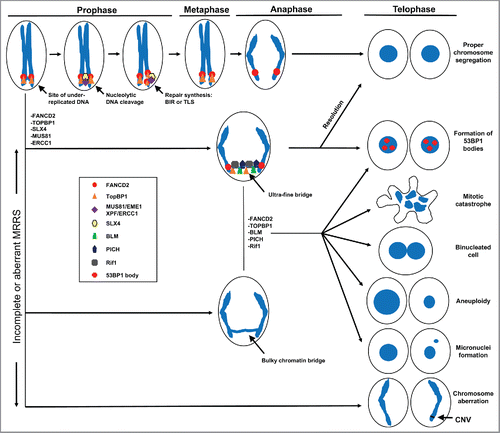Figures & data
Figure 1. Schematic diagram summarizing the cellular response to under-replicated DNA that persists in mitosis. FANCD2 and TopBP1 bind at sites of incomplete DNA replication during late G2/early prophase. Then, with the help of SLX4, the endonucleases MUS81 and ERCC1 bind at these sites and mediate nucleolytic cleavage of replication intermediates. This allows repair synthesis to occur to complete DNA replication and/or resolution of joint molecule intermediates, promoting proper chromosome segregation. In the absence of FANCD2, TopBP1, SLX4, MUS81 or ERCC1, a bulky or ultra-fine anaphase bridge (UFB) may form from interlinked or under-replicated DNA. The UFB may be resolved before completion of anaphase with the help of FANCD2, TopBP1, PICH, Rif1 and BLM, or transition into 53BP1 bodies in the daughter cells. However, unresolved joint molecule intermediates, persistent UFBs and bulky chromatin bridges, lead to chromosome disjunction, segregation defects and cell division abnormalities, which result in mitotic catastrophe, binucleation, aneuploidy or formation of micronuclei. Finally, nucleolytic cleavage and aberrant repair of under-replicated DNA in prophase may also lead to chromosomal deletions, amplifications or rearrangements that have detrimental consequences for the cell.

